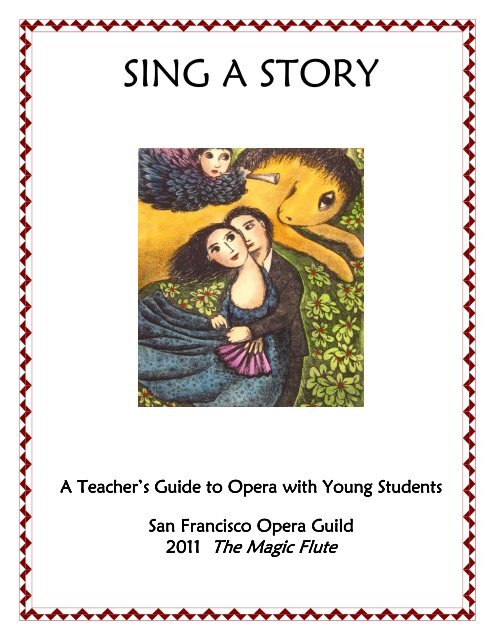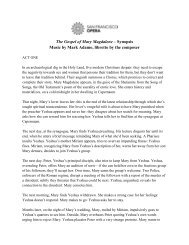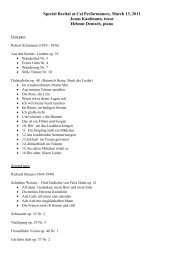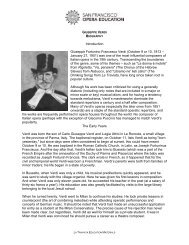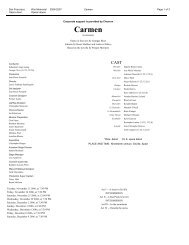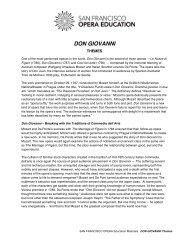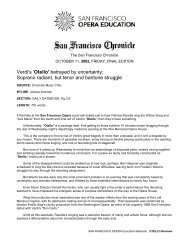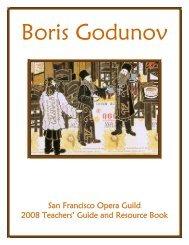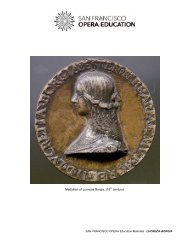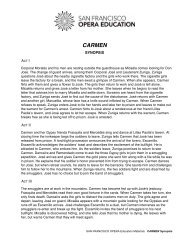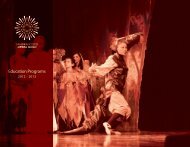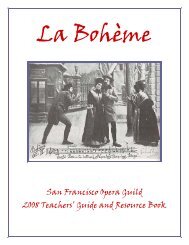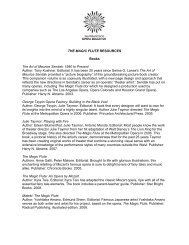You also want an ePaper? Increase the reach of your titles
YUMPU automatically turns print PDFs into web optimized ePapers that Google loves.
SING A STORY<br />
A A Teacher’s Teacher’s Teacher’s Guide Guide to to <strong>Opera</strong> <strong>Opera</strong> with with Young Young Young Students<br />
Students<br />
<strong>San</strong> <strong>San</strong> <strong>Francisco</strong> <strong>Francisco</strong> <strong>Opera</strong> <strong>Opera</strong> Guild<br />
Guild<br />
201 2011 201 <strong>The</strong> <strong>The</strong> <strong>The</strong> <strong>The</strong> <strong>Magic</strong> <strong>Magic</strong> <strong>Magic</strong> <strong>Magic</strong> <strong>Flute</strong> <strong>Flute</strong><br />
<strong>Flute</strong> <strong>Flute</strong>
Table of Contents<br />
Introduction: Sing a Story in Your Classroom ...................................................page 2<br />
<strong>The</strong> Story of <strong>The</strong> <strong>Magic</strong> <strong>Flute</strong> .................................................................................page 3-4<br />
Literacy<br />
Multi – Lingual Vocabulary Chart ............................................................page 5<br />
History<br />
About the Composer.....................................................................................page 6<br />
Geography<br />
Learning about Maps ..................................................................................page 7<br />
Map of Europe..............................................................................................page 8<br />
Map of Germany..........................................................................................page 9<br />
Map of California.........................................................................................page 10<br />
Music and Art<br />
<strong>The</strong> Bell Chorus Music Lesson ...................................................................page 11<br />
Music and Action .........................................................................................page 12<br />
<strong>The</strong> Journey of Pamina and Tamino..........................................................page 13<br />
<strong>The</strong> Journey Game.......................................................................................page 14<br />
Combining Art with Music.………….……..……………….……….……page 16<br />
Writing<br />
New Endings.................................................................................................page 17<br />
Coloring Pages (Grades k – 3)<br />
Coloring Pages Suggestions.........................................................................page 18<br />
Large bear.....................................................................................................page 19<br />
Small bears ...................................................................................................page 20<br />
Snake Tail .....................................................................................................page 21<br />
Crown............................................................................................................page 22<br />
Tiara..............................................................................................................page 23<br />
Tamino’s Search...........................................................................................page 24<br />
Teacher’s Evaluation Forms...………………………………….………………...page 25<br />
CREDITS:<br />
Jennifer Ashworth; Beth Brill; Tom Golden; Stephanie Losee; Elaine Romanelli; Dawn Roth;<br />
Anna Stinsman; Cate Thomason-Redus; Katherine Wong; Young Patronesses of the <strong>Opera</strong><br />
Boosey & Hawkes, for permission to use excerpts from Andrew Porter’s <strong>The</strong> <strong>Magic</strong> <strong>Flute</strong><br />
Cover Art: Ann Smith<br />
Copyright 2004; <strong>San</strong> <strong>Francisco</strong> <strong>Opera</strong> Guild Revised 2011
Sing a Story in Your Classroom<br />
Hello, and welcome to the Sing a Story Teacher’s Guide. Sing a<br />
Story is an in-class program designed to introduce your students<br />
to opera through storytelling. In the process of learning the<br />
story of <strong>The</strong> <strong>Magic</strong> <strong>Flute</strong>, your students will hear music and<br />
participate in a dramatic retelling of the story using props and<br />
costumes.<br />
This Teacher’s Guide is meant to help continue art, music, drama<br />
and writing in classwork with your students after the in-class<br />
performance.<br />
We have tried to order the suggested lessons by level of<br />
difficulty, and have grouped most of them by subject. <strong>The</strong> Table<br />
of Contents on the next page will tell you where to find lessons by<br />
subject matter and title.<br />
We hope that this guide will be useful to you in your continuing<br />
exploration of arts in the classroom, and we welcome your<br />
feedback.<br />
You may give us your feedback on this program by completing and<br />
returning the Teacher’s Evaluation Form at the end of this guide.<br />
We look forward to reading your comments, and integrating your<br />
ideas into upcoming incarnations of Sing a Story.<br />
Susan Malott Caroline Altman<br />
Managing Director Director of Education<br />
<strong>San</strong> <strong>Francisco</strong> <strong>Opera</strong> Guild <strong>San</strong> <strong>Francisco</strong> <strong>Opera</strong> Guild<br />
2
<strong>The</strong> Story of <strong>The</strong> <strong>Magic</strong> <strong>Flute</strong><br />
Our story begins in a magical land that is ruled by the Queen of<br />
the Night. Traveling through this land is a handsome prince<br />
named Tamino. Suddenly a giant serpent is chasing Tamino and as<br />
it gets closer he faints in fear. <strong>The</strong> serpent is just about to eat him, and<br />
suddenly Three Ladies with magical powers appear and kill the serpent with<br />
their magic wands. <strong>The</strong> Ladies look at the handsome Tamino, and think he’s<br />
pretty cute! So they go to tell their Queen, the Queen of the Night, about<br />
him.<br />
After the Three Ladies leave, a strange little man, named Papageno, sees<br />
Tamino lying there. Tamino wakes up, sees the dead serpent, sees Papageno,<br />
and thinks that Papageno killed the serpent. He asks, “Did you kill this<br />
serpent?” Papageno lies and says, “Yes!” <strong>The</strong> Three Ladies<br />
overhear Papageno’s lie and, using their magic, they lock up<br />
Papageno’s mouth. This way he cannot tell any more lies.<br />
<strong>The</strong>n the Three Ladies give Tamino a necklace with a picture in it.<br />
<strong>The</strong> picture is of a beautiful girl. She is so beautiful that Tamino<br />
instantly falls in love with her!<br />
Tamino is taken to the Queen of the Night who tells him that the beautiful<br />
girl in the picture is her daughter, Pamina. <strong>The</strong> Princess Pamina has been<br />
kidnapped by an evil, powerful man named Sarastro. <strong>The</strong> Queen promises<br />
Tamino that if he rescues Pamina, he may marry her. Tamino agrees, and<br />
after the Three Ladies unlock Papageno’s mouth he agrees to help too. To<br />
help them on their journey the Queen gives Tamino and Papageno magic<br />
gifts. Tamino gets a magic flute, and Papageno gets magic bells.<br />
Tamino and Papageno set out to find Pamina, but they get separated.<br />
Papageno finds Pamina first, and tells her about the brave prince that is<br />
coming to rescue her. After hearing all this Pamina falls in love with Tamino<br />
too. <strong>The</strong>y set out to find him, but before they can escape, they are<br />
captured by Sarastro’s servants who try to chain them up. Papageno gets an<br />
idea and plays the magic bells. <strong>The</strong> sound of the bells enchants the servants,<br />
and they dance away. Now Papageno and Pamina are free to find Tamino.<br />
3
Meanwhile, in another part of the land, Tamino finds Sarastro’s home and<br />
bangs on the door saying, “Let Pamina go!” Sarastro comes out to talk to<br />
Tamino and tells him that the Queen lied and Sarastro is not evil. In fact,<br />
Sarastro was trying to protect Pamina. So Tamino promises not to hurt<br />
Sarastro. As a reward Sarastro allows Pamina and Tamino to get married,<br />
but first Tamino must undergo a set of trials to prove himself worthy.<br />
<strong>The</strong> first trial is the Trial of Silence. Tamino is not allowed to speak to<br />
anyone. Unfortunately at this very moment Pamina finally finds Tamino. She<br />
tells Tamino, that she loves him! But Tamino is in the Trial of Silence and<br />
can’t talk. And now Pamina thinks he does not love her!<br />
But Sarastro hears all this, and decides that Tamino has<br />
passed the Trial of Silence. Tamino may talk to Pamina again! Finally they<br />
can be together, except Tamino still has two more trials to go through. So<br />
Pamina decides to go through the trials with him.<br />
<strong>The</strong> next trial is the Trial of Fire. Tamino and Pamina are scared to walk<br />
through the fire so they decide to use Tamino’s magic flute to help them<br />
through. Thanks to the magic flute they make it through the fire safely.<br />
<strong>The</strong>y decide to use the magic flute for their final trial, the Trial of Water.<br />
Once again the flute protects them and they make it through the last trial<br />
safely.<br />
Now Pamina and Tamino can get married and live happily ever after. Only<br />
there is one problem. Pamina’s mother, the Queen of the Night, hears about<br />
the young couple befriending Sarastro and she is furious! She and her<br />
Three Ladies tiptoe up to Sarastro’s temple, ready to destroy everything<br />
and everyone in it. But just at that moment, Sarastro comes outside and<br />
uses his magical powers to open up the ground beneath their feet. <strong>The</strong>y are<br />
swallowed up into the ground! Now everyone can live happily ever after!<br />
Cate Thomason-Redus, <strong>San</strong> <strong>Francisco</strong> <strong>Opera</strong> Guild, Sing a Story 2006
<strong>The</strong> <strong>Magic</strong> <strong>Flute</strong><br />
Multi – Lingual Vocabulary Chart<br />
German English Spanish French Italian Chinese<br />
der Tag day el día le jour il giorno<br />
das Glück luck, fortune la suerte la chance la fortuna<br />
das Hertz heart el corazón le coeur il cuore<br />
der Mann man, husband el hombre/<br />
el esposo<br />
le homme il sposo<br />
die Musik music la música la musique la musica<br />
die Nacht night la noche la nuit la notte<br />
lieben to love amar aimer amore<br />
das Lied song la canción la chanson la canzone<br />
die Frau woman, wife la mujer/ la femme/ la donna<br />
la esposa, la épouse<br />
die Weib wife la esposa, la épouse/ la moglie<br />
la mujer la femme/<br />
Königin der Nacht Queen of the Night Le Reina de la La reine de la la regina della<br />
Noche<br />
nuit<br />
notte<br />
die Silberglökchen<br />
�<br />
die � Zauberflöte<br />
silver bells<br />
the magic flute<br />
Campanillas de<br />
plata<br />
la flauta<br />
cloches orgentes<br />
la flute magique<br />
Campane<br />
d’argente<br />
Flauto di<br />
encantada/<br />
mágica<br />
magica<br />
� Options for language activities:<br />
� Post words and their translations in strips in your classroom.<br />
� Add words (starting with any of the languages) as the semester progresses.<br />
� Other Options for language activities:<br />
� Write a SHORT (three line) scene using just English or just Spanish<br />
(or just Italian if you are fluent in Italian)<br />
� Write the scene again using more than one language.<br />
5
ABOUT THE COMPOSER<br />
Wolfgang Amadeus Mozart was probably the most important composer in the<br />
history of music.<br />
Mozart was born on January 27, 1756 in Salzburg, Austria into a musical<br />
family and showed his skill at music from a very young age. When he was five<br />
years old, he could both read and write music and could play keyboard and<br />
violin very well. As a child, he traveled throughout Europe, playing music in<br />
the courts of many kings and queens.<br />
He spent much of his busy life in Vienna, where he became famous, but he<br />
was not good with money, so he was often poor. In 1782, he married<br />
Constanze Weber against the wishes of his family, and had six children,<br />
though only two survived.<br />
Musically, this was a period of outstanding creativity which saw the<br />
production of many of his best known works. Mozart wrote symphonies,<br />
concertos, and operas. Some of his most famous operas are <strong>The</strong> Marriage of<br />
Figaro, Cosi Fan Tutte, and of course, <strong>The</strong> <strong>Magic</strong> <strong>Flute</strong>.<br />
Mozart died on December 5, 1791 at the young age of 35. He would have a<br />
strong influence on other great composers, such as Beethoven and Haydn.<br />
6
Geography Lesson<br />
Summary of Activity<br />
Students will examine the map of Europe. <strong>The</strong>n they will trace the outline of the<br />
maps of Germany and California, learning different cities and features of each.<br />
Time: 30 minutes<br />
Setting: Classroom<br />
Materials needed:<br />
Maps (provided)<br />
Tracing Paper<br />
Pencils or Crayons<br />
A Globe (optional)<br />
Subjects: World Geography<br />
Objective:<br />
Teach the children about different cities and countries in Europe using the<br />
birthplaces of great composers to start. Teach the children about the map of the<br />
state where they live.<br />
Procedure:<br />
• Make photocopies of the maps provided and explain different features (e.g.<br />
the border is the line between countries)<br />
• Using tracing paper, have children trace the border of the map of Austria to<br />
create a map of their own. Be prepared to show them where the city of<br />
Vienna is.<br />
• Using tracing paper, have children trace the border of the map of California<br />
to create a map of their own.<br />
• On the map of California, teach children to find the city where they live, and<br />
other important features (the state capitol, mountains, etc.)<br />
• If there is a globe or a large world map in the classroom, find different<br />
countries or cities around the world.<br />
7
Map of Europe<br />
This is a map of Europe. Europe is another continent, like<br />
North America, where you live. Most of the great<br />
composers of opera were born in Europe and traveled<br />
through many of the different countries there. How<br />
many countries are there in Europe? Do you know what<br />
different languages are spoken there?<br />
8
Map of Austria<br />
This is a map of Austria. Austria is the country where<br />
Mozart was born! Use a piece of paper and a crayon or<br />
pencil to trace the border of the map to make a map of<br />
your own! <strong>The</strong>n ask your teacher to show you where the<br />
capitol city of Vienna is. If Tamino had a map like this,<br />
maybe it wouldn’t have taken him so long to find Pamina!<br />
9
Map of California<br />
This is a map of California. California is the state where you live!<br />
Use a piece of paper and a crayon or pencil to trace the border<br />
of the map to make a map of your own! <strong>The</strong>n ask your teacher to<br />
show you where you live in California, and put a dot there. Now if<br />
you’re ever lost like Hansel and Gretel, you can find your way<br />
home!<br />
10
<strong>The</strong> Bell Chorus Music Lesson<br />
Vocal and Rhythm Exercises<br />
Relaxation<br />
� Stand in a circle with your students.<br />
� Everyone scrunches up their face as though sucking on a lemon.<br />
� Let your face relax. Shake it out, like a wet dog.<br />
� Scrunch up your shoulders as though they were hooked to your ears.<br />
� Let your shoulders relax. Shake them out.<br />
� Tense up your arms and squeeze your hands into fists.<br />
� Let your arms and hands relax. Shake them out.<br />
� Tense up your legs and crunch your toes.<br />
� Let your legs and toes relax. Shake them out.<br />
� Scrunch your whole body into a ball.<br />
� Stand up and stretch TALL. Shake out your whole body.<br />
Breathing<br />
� Take in the BIGGEST breath that you can<br />
� Let it out<br />
� Take in another HUGE breath and let it go a little at a time, counting out loud from 1 to 5<br />
� Repeat again, counting on one breath: 1 – 10; 1 – 20, 1 - 50! Or higher . . .<br />
SINGING!<br />
� Everyone yawn! Feel how the back of your throat stretches wide open<br />
� Take a very deep breath, yawn, and sing “LAAAA!”<br />
Music Teachers: Above is the excerpt from the Bell Chorus that is used in Sing a<br />
Story. You may teach it to your students as preparation for the program and/or as<br />
follow up.<br />
11
Music and Action<br />
Summary of Activity<br />
Students will listen to <strong>The</strong> <strong>Magic</strong> <strong>Flute</strong> and develop the beginnings for physical<br />
characterization of specific characters.<br />
Time: 30-45 minutes<br />
Setting: classroom<br />
Materials:<br />
• <strong>The</strong> <strong>Magic</strong> <strong>Flute</strong> CD<br />
• CD player<br />
• Chairs<br />
Subjects: Drama/ Physical <strong>The</strong>atre, Music<br />
Objective:<br />
Students will be able to identify characters and musical themes in <strong>The</strong> <strong>Magic</strong> <strong>Flute</strong>.<br />
Procedure:<br />
Musical chairs<br />
♦ Review the story of <strong>The</strong> <strong>Magic</strong> <strong>Flute</strong> briefly with the students.<br />
♦ Musical Chairs:<br />
� Set up chairs in a circle for every student in the class.<br />
� Take away one chair.<br />
� Play a selection from the CD and have students move around<br />
the chairs as it plays.<br />
� When you stop the tape, they have to sit in the nearest chair.<br />
� <strong>The</strong> student who is left standing can play again or be “out” if you are having a<br />
competitive game.<br />
Funny character walks<br />
♦ Pick a character in the story<br />
♦ Create a funny walk for that character<br />
♦ Students can show their walk and the others can guess which character<br />
they are walking as<br />
Everyone show their walks while playing music from preview CD.<br />
Carol Weinstein, <strong>San</strong> <strong>Francisco</strong> <strong>Opera</strong> Guild, 2000<br />
12
<strong>The</strong> Journey of Pamina and Tamino<br />
Summary of Activity<br />
Follow up from the Sing a Story performance. Students will be able to demonstrate<br />
through drawing and movement the tempo, mood and style of a given piece.<br />
Time: 45 - 90 minutes/in multiple sessions<br />
Setting: classroom<br />
Materials:<br />
• Butcher paper<br />
• pencils<br />
• crayons<br />
• <strong>The</strong> <strong>Magic</strong> <strong>Flute</strong> CD<br />
Subjects: literacy, music and visual arts<br />
Objective:<br />
Students will visually represent plot, characters and relationships in <strong>The</strong> <strong>Magic</strong> <strong>Flute</strong>, in<br />
the form of a large “map.”<br />
Procedures:<br />
• On a long (six foot+) piece of butcher paper, draw in a “path” winding along the<br />
sheet, from one end to the other.<br />
• Review the story of <strong>The</strong> <strong>Magic</strong> <strong>Flute</strong> with the students, emphasizing characters and<br />
place.<br />
• Hand out crayons and pencils.<br />
• Students may either draw in their favorite characters or events onto the map. Try to<br />
help them place the events generally – at either beginning, middle or end of the sheet.<br />
Promote the use of the entire sheet of paper.<br />
• Help the students write the names of their characters onto the map next to each<br />
character’s picture. Try using various languages to name the characters. (See the<br />
Multi- Lingual Chart on page 2)<br />
• Have the students sign their works and display it on the wall (s).<br />
Option:<br />
• Board game:<br />
♦ Create a life-sized Board game from either the map created in the previous<br />
exercise, or from the “Journey Game” on the next pages. Use masking tape on<br />
the classroom floor to create a “map” or Game Board of events in the story.<br />
♦ Students in-role: Students can use the “board” as their playing area in<br />
re-enacting scenes from <strong>The</strong> <strong>Magic</strong> <strong>Flute</strong>.<br />
♦ Give rewards for good teamwork.<br />
Further Options:<br />
• Play the music from <strong>The</strong> <strong>Magic</strong> <strong>Flute</strong>, while the students are drawing.<br />
• Create a basic “elements” diagram, showing the elements central to the story: Fire,<br />
Water, Earth, Air<br />
• Create another diagram showing the parts of the Cosmos: Sun, Moon, Stars etc.<br />
Carol Weinstein, <strong>San</strong> <strong>Francisco</strong> <strong>Opera</strong> Guild, 2004<br />
13
<strong>The</strong> Journey Game<br />
Courtesy <strong>Opera</strong> Funtime,a publication of Young Patronesses of the <strong>Opera</strong>.<br />
14
Courtesy <strong>Opera</strong> Funtime,a publication of Young Patronesses of the <strong>Opera</strong>.<br />
15
Combining Art with Music<br />
Summary of Activity<br />
Students will be able to demonstrate through drawing and movement the tempo, mood<br />
and style of a given piece.<br />
Time: 30-45 minutes<br />
Setting: classroom<br />
Materials:<br />
• white paper<br />
• newspaper<br />
• crayons<br />
• pencils<br />
• <strong>The</strong> <strong>Magic</strong> <strong>Flute</strong> CD<br />
• CD player<br />
Subjects: music and visual arts<br />
Objective:<br />
Students will visually represent changes in musical moods, tempos and style.<br />
Procedures:<br />
• Have the students place the white piece of paper in the middle of a sheet of<br />
newspaper (to protect the desks).<br />
• Hand out crayons and/or pencils.<br />
• Students may either draw with their eyes open or closed, though closed eyes tend to<br />
yield more interesting drawings. Explain to the students that they are to respond to the<br />
changes in the music. For example, when the music is fast they may draw quickly,<br />
when it is slow, they may be more slowly and deliberately, etc.<br />
• Promote the use of the entire sheet of paper.<br />
• Play the piece for a few minutes simply for listening.<br />
• Play the entire piece of music again, this time asking the students to draw while it<br />
plays.<br />
• After you turn off the music, have the students discuss with you why they drew<br />
certain ways.<br />
• You will probably want to play the whole piece again at this point, giving them<br />
several minutes to complete their works of art.<br />
• Have the students title their works and display them on the walls.<br />
Discussion Questions:<br />
• What do certain colors signify?<br />
• How are different emotions brought out in music (i.e in loud or soft sound, high or<br />
low pitches, fast or short notes)?<br />
• Does changing a tempo (speed of the music) or style change the feelings in a piece of<br />
music?<br />
Evaluation:<br />
Have the students repeat this exercise listening to a popular piece of music and a classical<br />
piece of music. Discuss the differences and similarities.<br />
Carol Weinstein, <strong>San</strong> <strong>Francisco</strong> <strong>Opera</strong> Guild, 2000<br />
16
New Endings<br />
Summary of Activity<br />
Follow up from the Sing a Story performance. Students will be able to demonstrate<br />
understanding of plot, and use of imagination through writing, art and/or dramatic play.<br />
Time: 45 - 90 minutes/in multiple sessions<br />
Setting: classroom<br />
GRADE LEVEL: 1st grade<br />
Materials:<br />
• Butcher paper<br />
• pencils<br />
• crayons<br />
• <strong>The</strong> <strong>Magic</strong> <strong>Flute</strong> CD<br />
Subjects: art, drama and literacy<br />
Objective:<br />
Students will verbally, physically and visually re-interpret the ending of <strong>The</strong> <strong>Magic</strong> <strong>Flute</strong>.<br />
Procedures:<br />
� Drama/ Storytelling:<br />
� Making a Scene<br />
� Pick a scene out of the book<br />
� Choose one student to portray each character<br />
� Reread/ paraphrase the scene as the narrator.<br />
� Play the music (cued for each scene).<br />
� Encourage the students to act out their part of the scene as it comes along.<br />
� Art and/or Writing:<br />
� Option 1: Ask the children what happens after the very end of the story? How<br />
would they continue the story? Would Pamina and Tamino stay with Sarastro and<br />
go off to live in the Temple? What else might happen?<br />
� Ask them to:<br />
• Tell their ending and/or<br />
• Write down their ending and/or<br />
• Make a picture for it and/or<br />
• Act out the ending<br />
� Option 2: Ask the children how they would change the ending of the story- i.e.<br />
what do they think should happen to the Queen? To Papageno? To Sarastro?<br />
� Ask them to:<br />
• Tell their ending and/or<br />
• Write down their ending and/or<br />
• Make a picture for it and/or<br />
• Act out the ending<br />
17
Coloring Pages<br />
Suggestions:<br />
Big Bear…….……………………………………………………..………………..page30<br />
Hand puppet:<br />
Make two copies for each child<br />
Ask the children to color their bear (s)<br />
Cut out the bears.<br />
Glue the bears together around the edges, leaving enough space inside for a child’s hand.<br />
Full page drawing<br />
Cut it out use and on larger art work (posters, map illustration, or as collage)<br />
Little Bears……………………………………….……..………………………...page 31<br />
Popsicle stick puppet:<br />
Make a copy of the page for each child<br />
Ask the children to color their bear (s).<br />
Cut out the bears.<br />
Glue the copies together around the edges, leaving enough space inside for a popsicle<br />
stick.<br />
Slide the puppet over a popsicle stick and either glue or tape onto the stick.<br />
Full page drawing<br />
Use on larger art work (posters, map illustration, or as collage)<br />
Snake Tail……………………………………………..…………………………..page 32<br />
Color it<br />
Full page drawing<br />
Cut it out and:<br />
Use on larger art work (posters, map illustration, or as collage)<br />
Use as a wall or ceiling hanging/decoration<br />
Wear it! Let the children wrap it around their wrist and arm<br />
Crown…………………………………………………………….………………..page33<br />
Full page drawing<br />
Cut it out and use on larger art work – posters, maps(as collage)<br />
Use as a wall or ceiling hanging/decoration<br />
Wear it! Cut it out, paste the ends together and wrap it around the children’s head<br />
Tiara……..……………………………………………………...………………….page34<br />
Full page drawing<br />
Cut it out and use on larger art work – posters, maps(as collage)<br />
Use as a wall or ceiling hanging/decoration<br />
Wear it! Cut it out, paste the ends together and wrap it around the children’s head<br />
Tamino’s<br />
Search………………………………………………………………….…………...page35<br />
Color it<br />
Search game: Children may work individually or in teams<br />
Crafts Resources………………………………………………………….………page36<br />
18
Big Bear
Little Bears
Snake
Crown
Tiara
Courtesy <strong>Opera</strong> Funtime,a publication of Young Patronesses of the <strong>Opera</strong>.<br />
24
Teacher Evaluation<br />
Sing a Story 2011: <strong>The</strong> <strong>Magic</strong> <strong>Flute</strong><br />
School________________________ Participating Teacher_______________<br />
Grade_______ Years involved w/Sing a Story?________________________<br />
1. Were you able to integrate <strong>The</strong> <strong>Magic</strong> <strong>Flute</strong> into your lesson plans?<br />
2. If yes, how?<br />
3. Did Sing a Story help your students understand more about how music helps<br />
convey a story? How?<br />
4. Compare your students’ attitude toward opera before the program and after<br />
the performance.<br />
5. Did your students learn anything about history or culture by participating in<br />
this program?<br />
6. Did you see any change in classroom morale, cooperation, or self-esteem<br />
during participation in this program?<br />
7. What was the most important thing you feel your students learned while<br />
participating in Sing a Story?<br />
8. Anything else we should know?<br />
Thank you so much. Please return this form to<br />
<strong>San</strong> <strong>Francisco</strong> <strong>Opera</strong> Guild Education<br />
301 Van Ness Avenue, <strong>San</strong> <strong>Francisco</strong> CA 94102<br />
Guildeducation @sfopera.com


